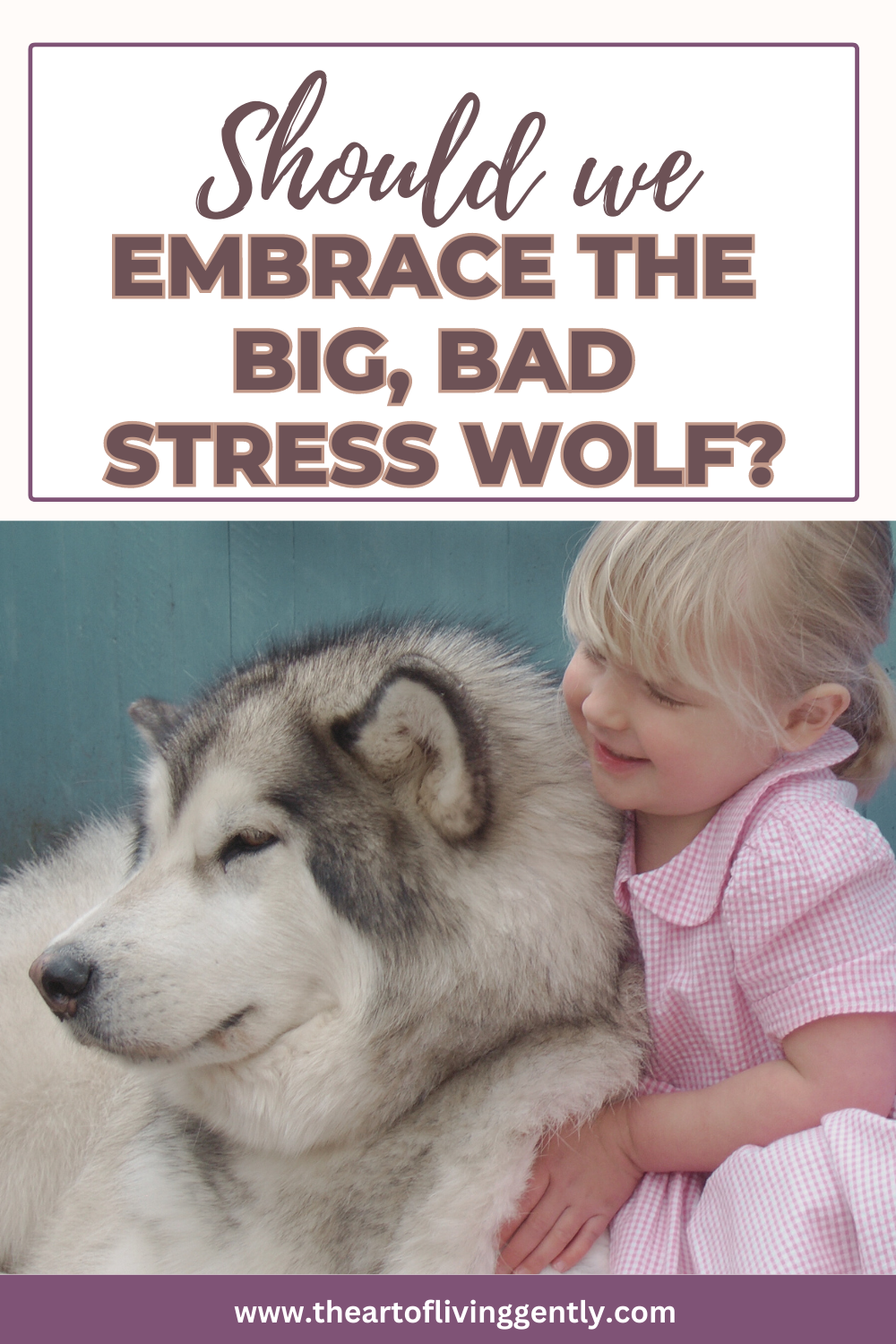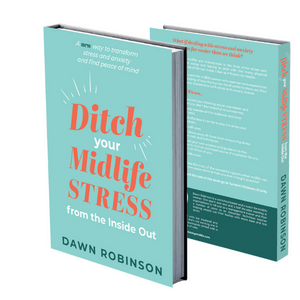Is it time we learned to embrace the big, bad wolf of stress?
Photo of my daughter cuddling the lovely Freya who is sadly no longer with us
A different way of looking at stress
You don’t have to look very far to find doom and gloom statistics about the dangers of stress. There are plenty of reports about how it can dramatically reduce the quality and length of our lives, how it’s eroding our health, or damaging our mental stability.
So, I wanted to share some amazing research that suggests rather than running screaming from the Big Bad Wolf of Stress, we might be better served by learning to see the fluffy, cuddly, lamb beneath the frightening exterior.
A new understanding of stress
If you liked this post please share it to pinterest
The work I’m using here is from the fantastic book “The Upside of Stress.” written by health psychologist Kelly McGonigal who works at Stanford in the US. Kelly spent years teaching as many people as she could get her hands on about the harmful effects of stress but in her subsequent Ted talk, she admitted she had changed her mind.
It turns out new research has shown that the harmful effects of stress only exist if you believe stress is harmful.
Reality is more subjective than we previously suspected and it’s our belief about stress and what it does to our health – body and mind that makes all the difference.
One of the first studies she came across that sowed the seeds of doubt for her involved over 30,000 people in the US. Researchers asked people two questions. Firstly, how much stress they had experienced in the last year and secondly, if they thought stress was harmful to their health? Then these diligent researchers tracked death records for the next eight years to uncover who died and who stayed alive.
As you would expect, the people who reported low stress were fine and the highest death rate was in the group experiencing high levels of stress who believed it was harmful and damaging. They were forty-three percent more likely than average to die over those eight years.
But most surprisingly, the healthiest people were those living with high levels of stress who didn’t think it was a problem. Typically they felt any feelings of stress helped them deal with challenging circumstances in their lives, giving them mental and emotional resources and the resilience to perform well.
Kelly came to the conclusion that believing stress is bad for you can seriously damage your health whilst working with it as positive energy, is life-enhancing. Stress isn’t some monstrous evil creature roaming the streets looking for hapless victims. It’s not something we have to tolerate and fight off as best we can as if using a folded umbrella to defend ourselves from a cartoon super-monster.
We have the potential to take an active role in how we respond to it - cowering and quivering, or standing and facing it, it’s up to us. But it’s a critical decision because the choice we make has a powerful role to play on the impact stress has on our physical and emotional health.
Beyond the fight or flight response
You’ve probably heard about the fight or flight response, our body’s response that enables us to fight or run and hide from danger.
But just assuming we’ve only got two ways of responding to stress is too simplistic - researchers have discovered the body is far more sophisticated than this.
The fight or flight response is just one way the body can respond to stress. More specifically it happens when we’re in self-defense mode because it’s a threat response.
When this response is triggered, the body is anticipating injury and restricts blood flow and increases blood pressure and inflammation – all designed to limit blood loss and encourage healing which if you’ve just been hit over the head with a mallet is handy.
These responses are wonderful in the short term and a great response to an immediate problem. But if maintained over time, they are the very triggers for health problems like heart disease and chronic inflammation we associate with stress.
The challenge response
But think about those times when you’re feeling stressed because you need to do well in a job interview or presentation, some form of sport or a time when you simply want to perform to the best of your ability. In situations like these, a little adrenaline and stress can make a world of positive difference.
Our mind is sharper, our physical reactions faster and we may even find we’re enjoying the very situation we’d dreaded. Our attention is focused completely in the moment and we know exactly what to say and do at precisely the right time.
We feel as if our performance is on fire and there’s little effort involved.
This is what’s called a challenge response and the body reacts in exactly the same way it does when we’re experiencing joy and courage. Blood vessels stay relaxed, the heart pumps faster. Our thinking is clear and our senses sharp.
Both the challenge and threat response have their place although the former is a healthier long-term response to stress. But how does the body know which response to use?
This is clearly a handy question to know the answer to and I’m not going to keep you in suspense for long! The trigger for which mode is turned on is our perception of our ability to handle whatever is causing our stress.
Let’s imagine you’re about to be trampled by a hoard of racing buffalo (unlikely to happen I know on the streets of most cities, but indulge me in this one for a moment). You quickly deduce your chances of being able to get away or outrun this multitude are slim. Body alarm bells are triggered and your threat response is activated, ready to limit the damage as far as possible.
If on the other hand, you have exactly one hour to finish a vital presentation before you stand in front of an important audience but have every confidence in your ability, the challenge response will help you get more done, faster.
When you are able to remind yourself how you have handled tricky situations in the past and can become absorbed in the challenge, the task becomes one of experiencing that elusive flow state rather than overwhelm.
As you look back over your life you might also notice how so often it’s the difficult times in our lives that turn out in hindsight to be the catalyst for significant personal growth.
I know this can be difficult to imagine when you’re going through a stressful time and life seems tough but if you reflect on your own experience, you may notice this to be true. It’s not until we’re tested that we uncover our true strength and resilience.
Through times of difficulty, we develop new skills and uncover unknown resources. We find inner strength we had never realised was there.
We amaze ourselves.
How to live with stress
I hope this has started you to question any previously held thoughts that stress is harmful to your health and to be avoided at all costs. I’m not suggesting for one moment this means you need to rush out into your life to find more stress to grapple with and if you’re having an easy life, you need to start worrying and feeling guilty.
But when you are stressed, rather than using avoidance techniques (especially hiding in a large cupboard as suggested in a previous chapter), seeing stress differently is a huge advantage.
We know that what you believe about stress is so important and it’s clear that engaging with any stressful situation by encouraging a challenge rather than the threat response can make a big difference.
Don’t allow yourself to be squashed by stress. You have the ability to deal with what life throws at you and you never know you might even find that stress wolf isn’t so scary after all!
Want to read more?
DitchYour Midlife Stress from the Inside Out
Available now on Amazon
What if stress and anxiety are not the problems we think they are and dealing with them is far easier than we can imagine?
For many women, midlife and menopause is the time when stress and anxiety seem to get worse.
Dealing with all the responsibilities of life as well as coping with the many physical and emotional challenges of this time of life can make it feel as if there's no respite.
But there is an answer.
In this book you'll learn..
• How to turnaround your thinking about stress and anxiety so that you never need fear stressful circumstances, ever again.
• Why you already possess all the resilience, inner strength and wellbeing you could want to deal with life's challenges.
• How easy and effortless it can be to stop the stress and anxiety overwhelm.
• How to relax with ease.
• Why you can throw away all those time-consuming stress management tools and techniques - no chanting, meditation, visualisation or squashy stress balls required.
• How to unleash your own wisdom and guidance so that you know where and how to find an unlimited source of inspiration for any problems life can throw at you.
• How to enjoy your life more.




